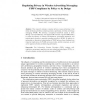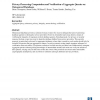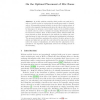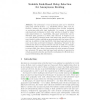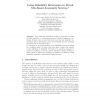PET
2009
Springer
14 years 6 months ago
2009
Springer
This research analyzes consumer privacy issues pertaining to the newly developing wireless marketing context, specifically, wireless advertising messaging (WAM). We develop a conce...
PET
2009
Springer
14 years 8 months ago
2009
Springer
: © Privacy-Preserving Computation and Verification of Aggregate Queries on Outsourced Databases Brian Thompson, Stuart Haber, William G. Horne, Tomas Sander, Danfeng Yao HP Labor...
PET
2009
Springer
14 years 8 months ago
2009
Springer
As the global society becomes more interconnected and more privacy-conscious, communication protocols must balance access control with protecting participants’ privacy. A common ...
PET
2009
Springer
14 years 8 months ago
2009
Springer
Delivery of products bought online can violate consumers’ privacy, although not in a straightforward way. In particular, delivery companies that have contracted with a website kn...
PET
2009
Springer
14 years 8 months ago
2009
Springer
Abstract. In mobile wireless networks, third parties can track the location of mobile nodes by monitoring the pseudonyms used for identification. A frequently proposed solution to...
PET
2009
Springer
14 years 8 months ago
2009
Springer
We present the Vida family of abstractions of anonymous communication systems, model them probabilistically and apply Bayesian inference to extract patterns of communications and u...
PET
2009
Springer
14 years 8 months ago
2009
Springer
Today’s Internet architecture makes no deliberate attempt to provide identity privacy—IP addresses are, for example, often static and the consistent use of a single IP address ...
PET
2009
Springer
14 years 8 months ago
2009
Springer
Abstract. Recent work has focused on hiding explicit network identifiers such as hardware addresses from the link layer to enable anonymous communications in wireless LANs. These ...
PET
2009
Springer
14 years 8 months ago
2009
Springer
The performance of an anonymous path can be described using many network metrics – e.g., bandwidth, latency, jitter, loss, etc. However, existing relay selection algorithms have ...
PET
2009
Springer
14 years 8 months ago
2009
Springer
There exist well established models for anonymity focusing on traffic analysis, i. e., analysing properties of single messages as, e. g., timing. However there is only little work ...
